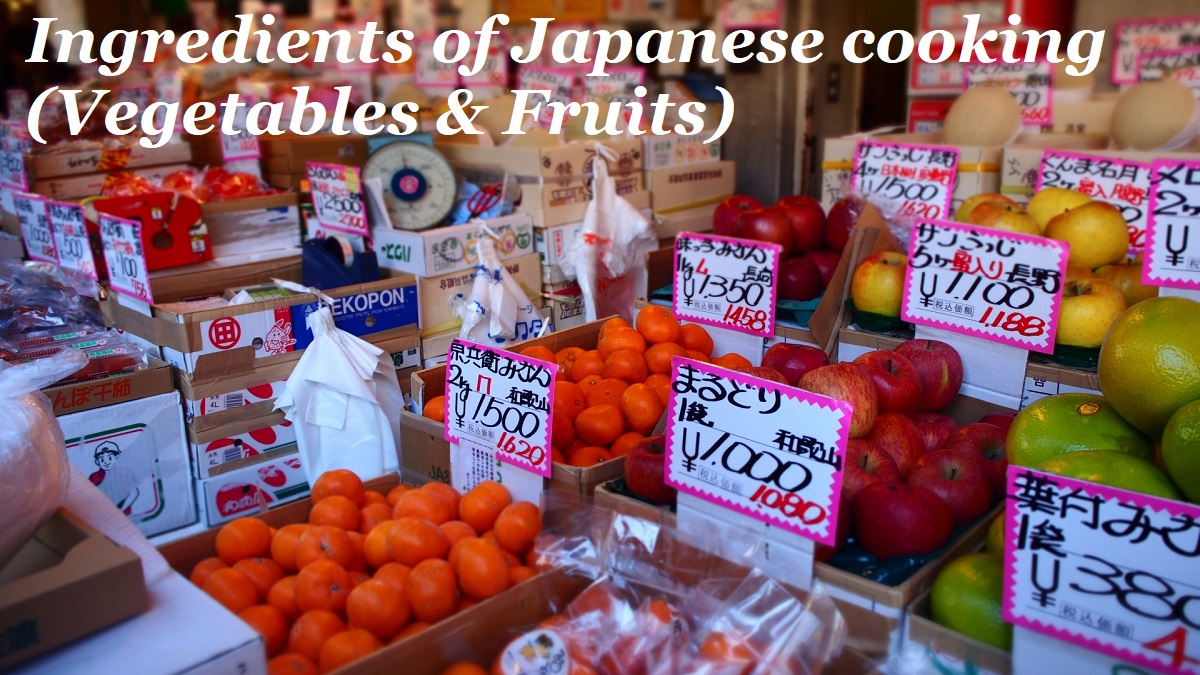Ingredients of Japanese cooking (Vegetables & Fruits)
Vegetables
Leaf vegetables
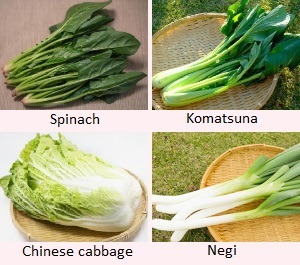
- Horenso (Spinach) : It is a popular leaf vegetable.
It is used mainly by boiling in water or soup. - Komatsuna (Japanese mustard spinach) : It has thicker stems and milder taste than spinach.
The season is winter. - Hakusai (Chinese cabbage) : It is softer than cabbage and used for various Japanese dishes.
We can eat it throughout the year, but the best season is winter. - Negi (Green onion) : The whole part is like soft stem and both green part and white part are eaten.
Chopped negi is used as the topping of noodles.
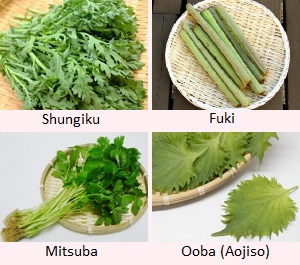
- Shungiku (Edible chrysanthemum) : The leaves and stems are eaten and the best season is winter.
It has mild bitter taste and is used for one pot dish. - Fuki (Japanese butterpur) : The long stem of big leaf is edible and the main season is spring.
The taste is a little similar to celery. - Mitsuba (Japanese honewort) : It is soft grass with long and thin stem.
It is used as potherb and the taste is light. - Ooba or Aojiso (Green perilla) : It is Japanese perilla and the green leaf is eaten.
It has unique refreshing taste and is used as potherb.
Stem and root vegetables
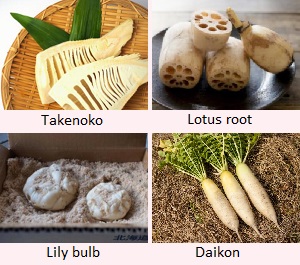
- Takenoko (Bamboo shoot) : It is the central part of new shoot from bamboo root.
It is harvested in early spring and is used for simmered dish. - Renkon (Lotus root) : It is harvested under the mud of pond and has about nine holes.
It is a little tough to chew and is used for simmered dish. - Yurine (Lily bulb) : It is edible bulb of lily and is sold in late autumn and winter.
The texture is like boiled chestnut and is mainly used for Chawan-mushi. - Daikon (Japanese radish) : It is one of popular vegetables used in various Japanese dishes and is as large as a leg below the knee.
It is used for simmered dish, or used as a fresh sauce by grating.
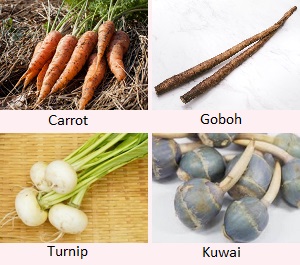
- Ninjin (Carrot) : It is often used for simmered dish.
It is sold throughout the year. - Goboh (Edible burdock) : It is a long root of a wild flower.
It has hard texture and unique smell, and is used after being boiled. - Kabu (Turnip) : It is mainly harvested in autumn and winter.
It is used for simmered dish. - Kuwai (Arrowhead) : It is a spherical root of a plant with a long bud.
The taste is similar to potato.
It is harvested in around December, so it is mainly used for New Year dish.
Fruit vegetables
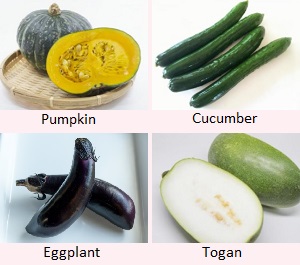
- Kabocha (Pumpkin) : It is one of worldwide vegetables and is eaten throughout the year in Japan.
It is used for simmered dish. - Kyuuri (Cucumber) : Because it contains much water, raw cucumber is used mixed with other chopped foods and dressing.
And it is used as pickles. - Nasu (Eggplant) : It is often used after grilling. And it is used as pickles.
There are some local varieties in Japan. - Toogan (Winter melon) : It is harvested in summer.
The fruit has mild and simple taste and is used for simmered dish.
Beans & Sprouts
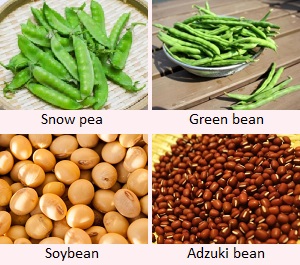
- Kinusaya (Snow pea) : The green pod of pea is eaten.
It is used after boiling in the water. - Saya-ingen (Green bean) : The green pod of pea is also eaten.
It is also used after boiling in the water. - Daizu (Soybean) : It is the most important bean in Japanese cuisine.
It is a raw material for miso, shoyu, tofu, natto, etc. rather than a bean for food. - Azuki (Adzuki bean) : It is boiled in water with sugar.
The sweet paste is called "an" and is used as one of the materials of Japanese confectionery.
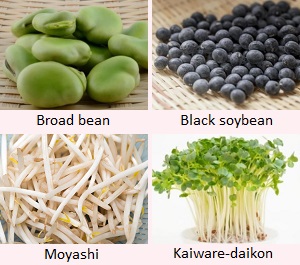
- Soramame (Broad bean) : It is used after boiling in the water.
The beat season is late spring. - Kuromame (Black soybean) : Mainly, it is boiled with suger.
The shining black beans are served as one of the dishes of New Year. - Moyashi (Bean sprout) : The sprout is white and the taste is mild.
The price is cheap and it is used as one of vegetables. - Kaiware-daikon (Radish sprout) : It is the sprout of daikon and has very thin stem and small green leaf.
The taste is a little sharp and is used as potherb.
Potatos
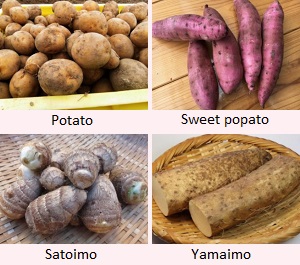
- Jagaimo (Potato) : It is used for new Japanese dishes since 19th century.
Usually, it is used with meat.
Of course, it is used for Western dishes. - Satsumaimo (Sweet popato) : The taste is sweet. It had been cultivated in poor land and was as an emergency crop at the famine.
Roasted sweet potato has been a good snack since poor periods. - Satoimo (Japanese taro) : It has been eaten since ancient times in Japan.
It is sticky and isn't sweet. - Yamaimo (Japanese yam) : Because of a part of root, the form is long.
After peeling the skin, it is slippery.
It is mainly used by grating.
Mushrooms
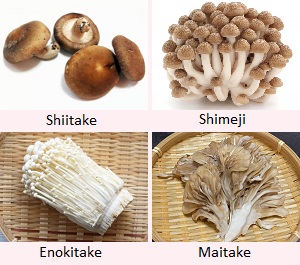
- Shiitake : It is the most common Japanese mushroom and is used for various dishes.
Dried shiitake is used for making Dashi broth. - Shimeji : It is also a common Japanese mushroom.
It is used for various dishes and the taste is mild. - Enokitake : General form is a bandle of very thin and white mushroom.
It is often used for hot-pot dish. - Maitake (Hen-of-the-woods) : The form is unique like many petals.
When it is used in soup, the color of the soup changes a little dark.
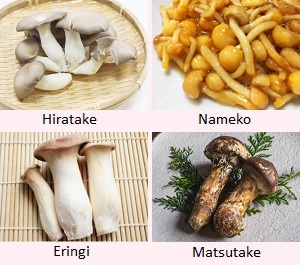
- Hiratake (Oyster mushroom) : It is sometimes used for various dish.
- Nameko (Butterscotch mushroom) : It is small mushroom covered with jellylike slime.
Mainly, it is used for miso-soup. - Eringi (King trumpet mushroom) : It has been cultivated since the 1990s.
The form is a thick stick and it is used for various dishes. - Matsutake : It is the highest grade mushroom in Japan.
It is impossible to grow matsutake, so the farmers must walk to find it in the forest in autumn.
Because the amount of harvested crop is small, the price is very expensive.
It is happy for Japanese people to enjoy the flavor and the texture of matsutake in mid-autumn.
Vegetables for Western-style dish
Japanese people may eat Western-style dish more than Japanese dish.
And they also like Chinese dish.
Of course, they are arranged for Japanese taste.
Therefore, the following vegetables you know very well are the main vegetables in the store.
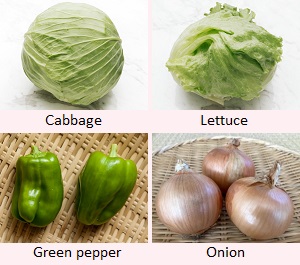
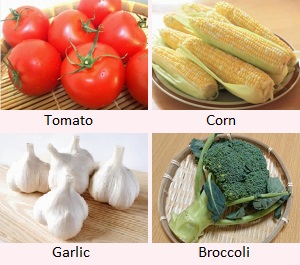
Wild Vegetables (Sansai)
There is a genre of vegetable named as "Sansai" in Japanese.
It is translated as "Mountain vegetables" in English.
They are edible wild plants which grow naturally in the open fields and mountains.
The dishes of sansai are served in the hotels and ryokans in such area.
Of course, there are many kinds of sansai and they have unique and wild aroma and taste.
The followings are the known ones.
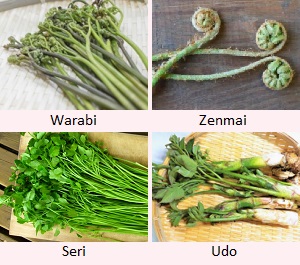
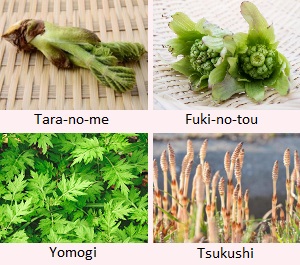
Seaweed
Japanese people often eat seaweed.
Only a few countries and Japan have the culture of eating seaweed in the world.
(I hear that a research team in France reported that only Japanese people had the bacteria in the intestines which can digest seaweed, in 2010.)
Of course, the kind of edible seaweed is limited.
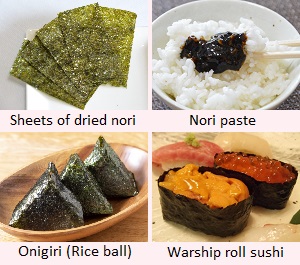
Nori is an essential ingredient for Japanese cooking.
Nori is a kind of algae and is cultivated near the coast.
It is dried around the coast and the product is like deep green, almost black, paper.
It has slight and mild flavor of sea.
Because it is like paper, nori is mainly used in the form of wrapping a food.
Especially, it goes well with boiled rice and is often used when "onigiri" (rice ball) and "sushi" are made.
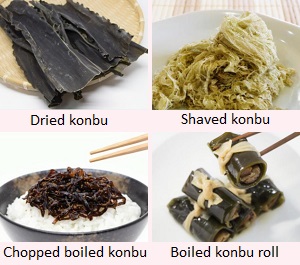
Konbu is also an important seaweed (or kelp) for Japanese people.
Konbu is a few meters long and is cultivated only near the coast in Hokkaido and northern Tohoku regions.
And, it is dried on the shore and becomes the product to sell in the market.
Dried konbu is soaked in water, then the delicate flavor dissolves into the water.
The taste is the important essence of basic Japanese "dashi" soup, so konbu is indispensable for Japanese cuisine.
Konbu is also used as an ingredient of Japanese dish.
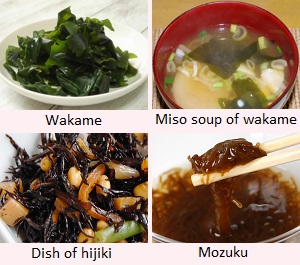
Wakame has been eaten since the ancient times in Japan.
The color is deep green and the texture is soft.
It is used for miso-soup and the other dishes.
Hijiki is black and short seaweed.
As a popular dish, hijiki is soaked it in water, then it is fried with a few vegitables.
Mozuku is thin and brown seaweed and is slimy.
In general, raw mozuku in vinegar is eaten.
Fruits
Fruits from spring to early summer
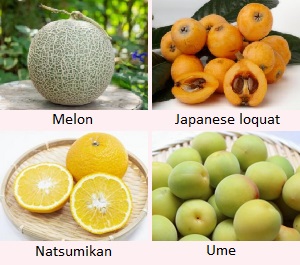
- Melon : Melon is a popular fruit and is widely cultivated in Japan.
But it is a little expensive. - Biwa (Japanese loquat) : Biwa is cultivated in the southern side of Japan.
It is a sweet fruit and the season is from May to June. - Natsumikan : Natsumikan is similar to grapefruit, but it is a little bitterer and juicier than grapefruit.
- Ume (Japanese apricot, Japanese plum) : Ume blossoms are beautiful in early spring and the fruits are born around May.
From the ume fruits, "Umeboshi" (salted ume pickles), "Umeshu" (ume liqueur) are produced.
Fruits in summer
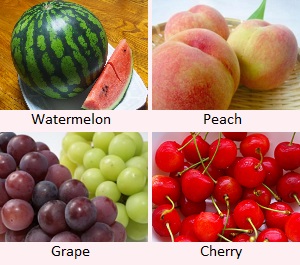
- Suika (Watermelon) : Suika is a popular fruit in summer in Japan.
Mainly, the flesh is red and the peel is green with black stripes.
There are some varieties such as no seed, yellow flesh. - Momo (Peach) : Japanese peach has mainly a pink color and the flesh is sweet.
It is cultivated in the middle of summer. - Grape : Grape is a worldwide fruit. In Japanese, it is called "budô".
There are many varieties and it is cultivated from early summer to early autumn. - Cherry : In Japanese, it is called "Sakuranbo".
Cherry blossoms in spring are famous, but can't bear fruit.
The fruits are from the other kind of cherry trees and are cultivated from June to July.
Fruits in autumn
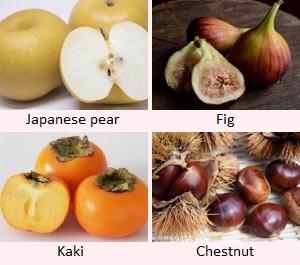
- Nashi (Japanese pear) : Japanese pear has the form and size similar to apple.
The flesh is sweet and juicy and has a little crunchy texture. - Ichijiku (Fig) : Fig is also sweet fruit.
It is cultivated mainly around early autumn. - Kaki (Persimmon) : It has been the common fruit of autumn in Japan since ancient times.
And it was introduced into Europe and America from Japan in the 18th to 19th centuries.
The taste is a little sweet but isn't sour.
Because a kind of kaki is very sour and bitter, people hang such kaki from the eaves and make dried fruit.
It is "Hoshigaki", and becomes very sweet dried fruit like jam in winter. - Kuri (Chestnut) : It is cultivated in autumn.
It is mainly used for Japanese sweets.
And boiled rice with kuri is an autumn food.
Fruits in winter
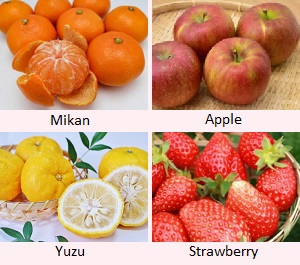
- Mikan : The formal English name is "Citrus unshiu".
It is one of popular fruits and a lot of mikan are sold in winter.
It is sweet and mild sour. It has few seeds.
It has the size of your palm, and you can peel it with your fingers easily. - Apple : Apple is a worldwide fruit. In Japanese, it is called "ringo".
In Japan, apple is almost eaten raw. - Yuzu : It is a kind of Japanese citrus and is used like lemon.
Squeeze of yuzu is used to add flavor for Japanese dish. - Ichigo (Strawberry) : Strawberry is a popular fruit from winter to spring.
In Japan, it is used for Christmas cake, so it is sold from around December.

